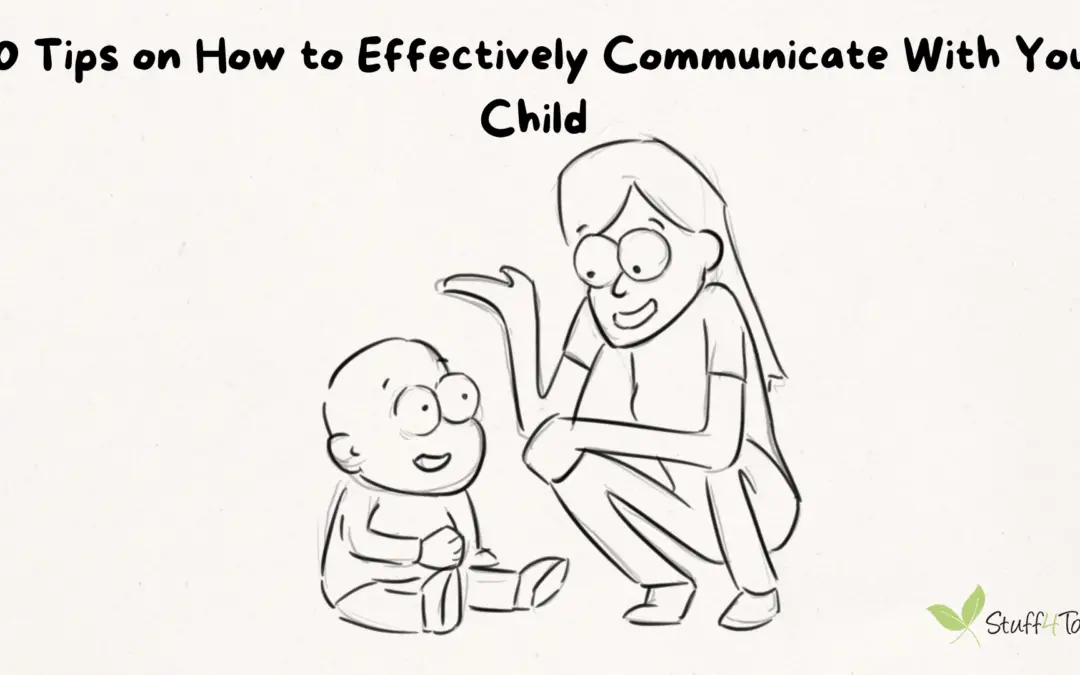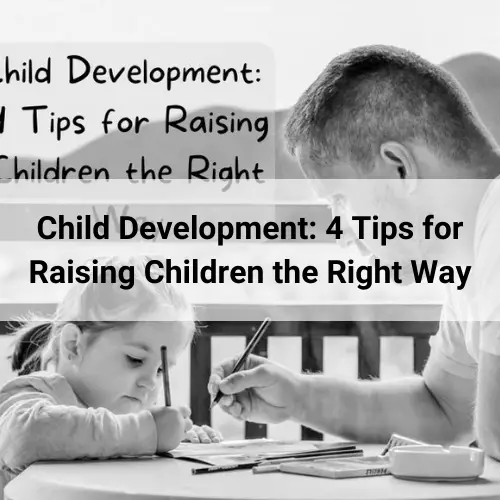Table of Contents
3 Different Ways Parents Communicate With Their Kids
#1 Aggressively
Aggressive parents yell a lot and use attacking or negative words.
For example: “I’m sick and tired of seeing your untidy room. Why are you too lazy to clean up after yourself? That’s it! I’m throwing out all your things and you’re grounded!”
A parent using this style refuses to listen to the child’s point of view at all and is typically harsh, angry, and cold.
When children hear aggressive words, they respond by acting out more, feeling fearful, yelling back, and ignoring their parents’ orders.

#2 Passively
Parents with this style go to the complete opposite extreme.
They are afraid to upset their children and so speak to them weakly and unassertively.
For example: “Oh sweetie, I see that you haven’t tidied up your stuff. I guess you were too busy with your toys to tidy up. I’ll clean your room for you so that it will be easy to find everything next time.”
This parent does not hold the child accountable for tidying up his room and does not show herself to be the authority figure at home.

Children who are at the receiving end of passive words walk all over their parents. They learn not to respect their parents.
The child just has too much power at home.
#3 Assertively
So far, assertive communication is the most effective way to interact with kids at all levels.
For example: “Sweetie, I see that your room is still a mess. It really bothers me that I can’t count on you to be responsible for your things. We need to come up with a plan on tidying up your room. Until we can agree on that plan, there will be no internet access for now.”
Assertive parents are willing to listen and yet still hold firm so that both the parent’s and the child’s needs are met.
The child is given an opportunity to participate in finding a solution.

Assertive words – firm, consistent, and positive ones – help your kids to realize the importance of always listening to Mom and Dad.
Assertive communication is an example of Authoritative Parenting. You can learn more about that in our video about the 5 common parenting styles.
Which communication style do you think you have?
Knowing which style you have will help you to know where you can make adjustments in carrying out the following 20 tips on how to improve your communication with your children.
Communicate with Your Child Effectively Using These 20 Tips!
#1 Say your child’s name
Saying your child’s name helps to get their attention. Once you’ve got their attention, deliver your message. Eg., “Billy, please go and get…” Often, young children can only focus on one thing at a time, so before you speak, say your child’s name until you have their full attention. For example, “Rosie…” (wait until she stops playing and looks at you.) “It’s snack time in five minutes.”#2 Make eye contact with your child
Get down to their level or invite them to have a chat with you at the family table. Call out your child’s name until they look at you. Once they do, you can proceed with giving them instructions or simply start a conversation. Gaining their attention is important; make sure to model the same behavior for them.#3 Be gentle, but firm
Stick to your decisions. Make it a point that both you and your partner agree on them. Your child may not like your decision, but they will know that it stands firm as Mom and Dad are united in their decision. Make your requests sound that you mean business. Requests delivered in a weak tone will tell your child that you are not too concerned about them following your directions or not.#4 Be mindful of the volume of your voice
If you usually employ a calm tone, then raising your voice in certain situations will put your child on alert, because it doesn’t happen all the time. Shouting directions from another room may prove to be ineffective. For example, shouting “Please turn off the TV now, Billy!” from the kitchen tells your child that you’re too busy and not serious about your request. To get your child’s attention, walk into the room before giving instructions. Demonstrate respectful behavior from the beginning and your child will know that you mean business! Amy McCready of Positive Parenting Solutions uses the term “Calm Voice” for this. Controlling your tone of voice and squelching your instinct to yell reduces stress for both you and your child. Your voice is a good indicator of your mood. Kids pick up on it and mirror your behavior. Yell and they yell. Speak calmly and your children will tend to adopt your calmness.#5 Prioritize having conversations with your children
Encouraging open communication with your kids helps them develop a closeness with you, cooperation, and self-esteem. Make an effort to foster your relationship by talking with your children with every opportunity you get. Remember that communication with your child is two-way. Be mindful that when speaking with them, you must also make an effort to listen to them. Listening and talking are equally important.#6 Use positive language
Make an effort to avoid saying “no” or “don’t”. If you say, “Don’t drop that glass”, your child will build that image in their mind. It’s most likely that they will drop the glass! Instead, tell them what you want them to do and use positive words while you’re at it. For example, “I trust that you’ll take good care of that glass as it’s special.” While using positive language requires much thought and practice, it’s all worth the effort. Try to eliminate negative sentences like “You’re a naughty boy”. Parenting guru Amy McCready says that negative words reinforce negative behaviors. Instead of a child hearing what you want him to do, he would be reminded of what he should not do. Also, negative words are discouraging. If 93% of the feedback you received during the day were negative, it’s most likely that you would feel discouraged. That’s how a child would feel. Negative language will leave your child feeling worthless. Positive words will give your child more confidence, resulting in more encouragement to strive to achieve success. When kids are confident in you, they will learn to imitate you and give the same respect and praise to others. An example of positive language is: “Thank you for remembering to pack up your toys before dinnertime”.#7 Demonstrate good manners
If you model good manners to everyone, your child will see that these are expected and to be practiced continuously. Teach your children to say “please” and “thank you”. Children will often adapt their parents’ speech and behavior. Be a good role model – say “please,” “thank you”, and “you’re welcome” to your kids as you would anyone else.#8 Keep your instructions simple
Be mindful that younger kids can’t focus on too many directions given to them. We can probably relate to that when we ask someone for directions which we will most likely forget! For example, say “Rosie, please tidy up your toys, but first put your dirty shoes outside and then feed the puppy.” What do you think Rosie will do? It’s most likely that she will just feed the puppy and then go outside to play. It’s because feeding the puppy was the last thing you requested her to do! Be mindful to make your requests in small chunks.#9 Check for understanding
If your child isn’t responding to your requests or seems confused by your instructions, make it a point to check if they understand things before moving on to another topic. Ask them to repeat what you have told them. If they’re unable to, then your request must have been quite difficult for them to understand. Use shorter and more straightforward sentences in rephrasing your request.#10 Use words that encourage conversation
Your kids will feel that you care enough to listen to them when you give them your full attention. For example, when you’re working on the computer, you surely can’t give your kids your full attention. If you don’t have time to talk to them, tell them. Don’t pretend to be listening. Give them a specific time when you can attend to them. Be mindful to show that you are interested in their thoughts and feelings by asking open questions that encourage conversation. For example, “How did that make you feel?” or “What did you do about it?”.#11 Explain what you want using “I” statements
You’ll find that using “I” statements when asking your child to do something will elicit a better response compared to using “you” statements. “I” statements tell your child how their behavior makes you feel. There are times when children don’t think about how their behavior will affect others. “I” statements help them to become responsible in changing their behavior. Try saying “I would like you to share your biscuits with your sister, please,” instead of “Share your biscuits with your sister”. Isn’t that a much softer approach? You’ll find that children who want to please others usually respond to this type of approach. Children will understand why they should follow your requests when you explain how you feel. An example would be “When you run away from mommy in the park, you could get lost. I feel worried about that.”#12 Don’t overdo things
Carry out your rules but try not to overdo things. If you often nag your child over little things, they will just stop listening. For example, if you always tell your child what they “ought” to be doing, your words will just go to waste. The downside of telling your child what they ought to be doing is they lose the opportunity to learn to think for themselves. Usually, a parent would say “You must focus in class, or you won’t understand a thing”. A helpful strategy would be to use questions that encourage conversations. Examples are “Why do you find it hard to focus in class?” or “What do you think you could do to focus more in class?”. When you use these types of questions, your child will be encouraged to think of ways to solve their problem or improve their behavior.#13 Give your child alternatives
When you want your child to cooperate, it is important for them to understand why they need to do something. They need to know why they should follow your directions. For example: – “When you get dressed for school, you may then play with your toys.” Use words like “when” and “which” to make your child feel as though they have choices, but bearing in mind there is no room for negotiation. These words work far better than “if” words. Encourage your child to help you solve a problem. Instead of saying “Don’t leave your favorite teddy bear there”, say “Billy, think about where you should place Teddy so he’ll be safe and dry. When you’ve found the perfect spot for him, let me know.” Try to offer alternatives rather than conveniently saying “no” or “don’t”. Check out available kid’s toys on Amazon for a job well done.#14 Encourage your child to think by asking open-ended questions
Think of questions that aren’t easily answered by a “yes” or “no”. These kinds of questions will encourage your child to share what’s on their mind. Instead of asking “Did you enjoy the movie?”, ask “What was your favorite part of the movie?”. Engaging in this type of conversation shows your child that you value their opinions and that they are important to you. Say things like “Really? I liked that part too!”#15 Be considerate
Try comparing the way you speak with fellow adults and the way you talk with your child. Do you use the same tone with both? Giving more thought into how you speak with your child will help to develop a more positive relationship between the both of you.#16 Show acceptance
It’s more likely that your child will share their thoughts and feelings with you when you make them feel that you genuinely accept and love them as they are. They will be confident in the fact that you will always be there for them no matter what. It is important for us parents not to allow inappropriate behavior and to fully accept our children – their personality and all. For example, Billy says, “Mom, I’m afraid to go to bed because it’s dark.” An encouraging response would be, “That’s alright, Billy. I’ll leave the door open and check on you later.” A bad response would be, “Only little boys get scared, Billy! Don’t be a crybaby!”#17 Resist the urge to interrupt
When your child is sharing his thoughts with you, avoid interrupting him. If you lecture them during this special time, it’s most likely that your child won’t be looking forward to sharing their feelings the next time.#18 Give your child a heads up
If it’s almost time to go and your child is still enjoying an activity with his playmates, give them a heads up so they’ll know that they need to wrap things up soon. For example, “Rosie, we’re leaving in a few minutes. Start saying goodbye to your friends, please.” Children are wrapped up in the moment and have no sense of time when they’re having fun. So if your opening line is “Rosie, pack up we’re leaving now”, she’ll likely need a few minutes to process the need to move on.#19 Avoid nagging
It’s important for your child to learn to clean up after themselves. However, if you request your child to tidy up their toys, empty the trash cans, and feed the puppy, nothing would get done. Again, it’s all about your child being unable to deal with too many instructions. A helpful workaround would be a job chart. Writing specific tasks will eliminate lots of nagging. It is essential to acknowledge your child’s efforts. Kids thrive on routines; it’s good to set a time to do their chores. If your child knows what is expected of them, nagging wouldn’t be necessary to get things done.#20 Make it a point to have one-on-one conversations
Note that this step is especially important if there is an age gap between your children. It usually happens that older children talk over the younger ones. Sometimes, the younger ones feel more comfortable in letting their older siblings do all the talking. A younger sibling may encounter a bit of difficulty when having a conversation with an older sibling due to his level of understanding. Dedicate one-on-one time with your children; schedule different times for each child. This way, you can focus on each child and talk with them using vocabulary that suits their level. You could have a chat while reading a book together before bed or while walking to the park. This one-on-one time doesn’t have to be structured. Once you see a chance to spend quality time with your child, go for it! Do you practice any or all of these 20 ways on communicating positively and effectively with your child?
We’d love to hear from you!
Let us know in the comments below.
You can also read our article about 100 Positive Parenting Affirmations which will help you overcome difficult days.
Do you practice any or all of these 20 ways on communicating positively and effectively with your child?
We’d love to hear from you!
Let us know in the comments below.
You can also read our article about 100 Positive Parenting Affirmations which will help you overcome difficult days.Related Articles:

Michael Oliver
Father of two lovely and special children. I'm an engineer (electrical) by trade and have worked at many a blue chip organization in the past. From Ford Motor Company to Airbus to Wyeth Pharmaceuticals to the UK National Health Service I've had a pretty diverse working life. After completing my MBA I wanted to break away from the corporate 'cubicle' so I founded Stuff4Tots as a means of being at home for my family and creating a future for us all.
Now as CEO of Stuff4Tots I bring together my expertise as a parent, a husband and a professional to serve fellow parents providing useful and relevant information and products to new families.






